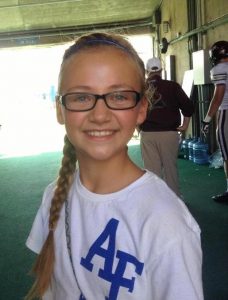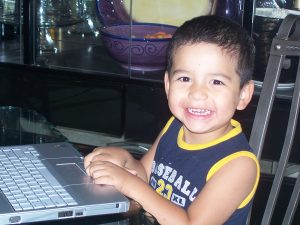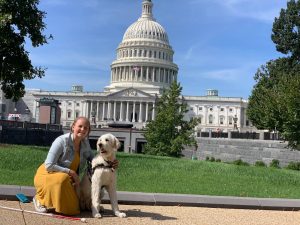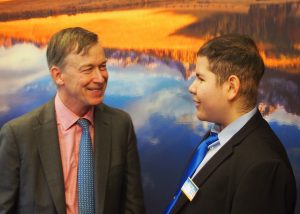Hannah and Gabe are teenage survivors of medulloblastoma, a type of brain cancer that is found primarily in kids. Medulloblastoma is the most common malignant brain tumor found in children, accounting for about 20% of all pediatric brain cancers.
 Prior to being diagnosed with cancer at age 12, Hannah was a huge athlete, competing in swimming, track, basketball, and volleyball. But frequent unexplained headaches over the course of several months finally lead to a diagnosis of a 6cm (tennis ball-sized) brain tumor in her cerebellum. Surgery, 31 radiation treatments, and 6 months of chemotherapy followed over the next 10 months as Hannah took on the toughest opponent of her life. She endured countless procedures, needle pokes, and hospital stays and came out the other side of cancer-free, but not unscathed.
Prior to being diagnosed with cancer at age 12, Hannah was a huge athlete, competing in swimming, track, basketball, and volleyball. But frequent unexplained headaches over the course of several months finally lead to a diagnosis of a 6cm (tennis ball-sized) brain tumor in her cerebellum. Surgery, 31 radiation treatments, and 6 months of chemotherapy followed over the next 10 months as Hannah took on the toughest opponent of her life. She endured countless procedures, needle pokes, and hospital stays and came out the other side of cancer-free, but not unscathed.
Gabriel was a normal, healthy, and active boy who was 9 years old and had just started 4th grade in the fall of 2013 when he was diagnosed with Stage IV medulloblastoma that had already spread to his spine. Gabe had emergency surgery to relieve the pressure in his brain and remove a portion of the tumor for biopsy. He spent a month in the hospital recovering, then endured radiation every day for 6 weeks, as well as 6 months of high dose chemotherapy and supplemental surgeries. Gabe missed an entire year of school because of treatment, often feeling lonely and isolated from his friends, but he hasn’t ever given up despite all of the challenges he continues to face.
was a normal, healthy, and active boy who was 9 years old and had just started 4th grade in the fall of 2013 when he was diagnosed with Stage IV medulloblastoma that had already spread to his spine. Gabe had emergency surgery to relieve the pressure in his brain and remove a portion of the tumor for biopsy. He spent a month in the hospital recovering, then endured radiation every day for 6 weeks, as well as 6 months of high dose chemotherapy and supplemental surgeries. Gabe missed an entire year of school because of treatment, often feeling lonely and isolated from his friends, but he hasn’t ever given up despite all of the challenges he continues to face.
Hannah and Gabe are teenage survivors of medulloblastoma. They’re cancer-free and out of treatment, but they still deal with medulloblastoma every day.
1 in 4 kids who survive cancer will have severe or life-threatening side effects from their treatment.
Hannah and Gabe are two such kids.
Hannah was nearly blind in the days following the surgery to remove her tumor. Her vision has improved in the years since, but she is visually impaired and legally blind in one eye. Gone are the days of volleyball and basketball. The adult doses of radiation mean that Hannah can never bear her own children, something she was told at the age of 12. The chemotherapy drug used resulted in neuropathy in her hands, fingers, feet, and toes, which causes tingling, burning, numbness, and sensitivity. Hannah lost her long blonde hair and it will never grow back the same again. The list of treatment late effects goes on and on.
Gabe, now almost 16, takes nearly a dozen medications each day and has to give himself injections every evening in an attempt to manage the pain, dizziness, and lethargy.
Not being able to keep up with his old friends is incredibly difficult for Gabe, and has resulted in a growing distance between them.
Turning personal experience into advocacy
After all they’ve been through and all they continue to face, Hannah and Gabe aren’t letting cancer get the best of them. Instead, they’re speaking up and doing – all in support of other kids like them with cancer.

This past September, Hannah and her parents traveled to Washington, D.C. to participate in the 10th Annual Childhood Cancer Summit at the United States Capitol. Hannah spoke to the audience about her experience with cancer with her trusty sidekick and mobility dog, Ned, by her side. Hannah explained that Ned’s name is a reference to the medical acronym short for “no evidence of disease,” the term patients and their parents long to hear from their oncologist. While introducing Representative Michael McCaul, founder and co-chair of the Congressional Childhood Cancer Caucus, Hannah made the audience laugh, cry, and provided them with an idea of the extent of the effect medulloblastoma has had on her life. “I’ve had to find new activities, like tandem bike riding and a sport for the blind called goalball. I’ve had to find new ways to do old activities, like skiing and running. Now I use a guide. My life is different, but I didn’t let cancer win.”
During his treatment, Gabe asked his mother, “Why don’t kids have special plates with the gold ribbon so people know about us? Can we  make license plates for all the kids who have cancer?” Of course, his mother promised him she would do everything she could to create a license plate to promote childhood cancer awareness.
make license plates for all the kids who have cancer?” Of course, his mother promised him she would do everything she could to create a license plate to promote childhood cancer awareness.
Gabe completed his treatment in 2014 and together they embarked on the journey to make the Colorado Childhood Cancer Awareness license plate a reality, and they have done just that! After more than a year of gathering petition signatures, attending and testifying at legislative hearings and votes in the Colorado Senate and House of Representatives, “Gabe’s Plate” was signed into law by then-Colorado Governor John Hickenlooper on May 22, 2018!
Thanks to your support, Hannah and Gabe know they are not alone in the effort to raise awareness of childhood cancer. You help bolster their resolve and commitment by listening and sharing their stories. Your donations and support of pediatric cancer research that improves and saves lives proves that they can be a voice and make a difference in the world. Hannah and Gabe are making a difference and so are you.

